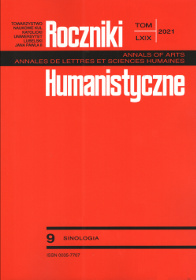The Evolution of China’s Political System in the Reform and Opening-Up Era: Structures, Processes and Challenges. Part II 2012-2020
Abstract
This paper analyses key developments within the PRC power structure and the Party’s leadership since the 18th Party Congress in the year 2012. The so-called “collective leadership”, which was the main decision-making mechanism in China during the 2000s, proved to be ineffective in terms of governing the country and managing intra-party affairs. With Xi Jinping’s rise to power after the 18th Party Congress, the governing apparatus has undergone a centralisation of power which has resulted in a significant shift in authority, from the main Party factions and government institutions to bodies under the direct supervision of the Secretary General. Xi Jinping’s main objective was the streamlining of the decision-making process and making the implementation of reforms more effective. Introducing such a governing model, significantly different from the well-established, since the 90s, “collective leadership”, began to be perceived as “one-man rule” and was followed by severe disciplinary measures, such as an anticorruption campaign, aimed at the weakening of influential factions and interest groups within the Party and government institutions.
The last decade has also witnessed the formation of new groups in China’s ruling elite. Apart from the all-powerful Xi Jinping and his inner-circle of aides and political protégés, some new factions have emerged, being mainly associated with a certain view of China’s future development model (liberals, leftists, China-model advocates, intra-party reformers, etc.). The period since the 18th Party Congress has experienced a significant increase in the role of think-tanks, research bodies and experts in top-level policy planning.
References
Bogusz, Michał, i Jakub Jakóbowski. Komunistyczna Partia Chin i jej państwo. Konserwatywny zwrot Xi Jinpinga. Ośrodek Studiów Wschodnich im. M. Karpia, 2019.
Burski, Ksawery. „Biuro Polityczne KPCh na ciągłym szkoleniu”. Azja-Pacyfik, t. 18, 2015, ss. 280-284.
Burski, Ksawery. „Rozkwit chińskich think-tanków i nowe oczekiwania wobec nich”. Azja-Pacyfik t. 18, 2015, ss. 271-279.
Cheng, Li. Chinese Politics In the Xi Jinping Era. Reassessing The Collective Leadership. Brookings Institution Press, 2016.
Cheng, Li. „Xi Jinping Inner Circle”. China Leadership Monitor, Hoover Institution, cz. 1: „The Shaanxi Gang”, t. 43, 2014; cz. 2: „Friends From Xi’s Formative Years”, t. 44, 2014; cz. 3: „Political Proteges From the Provinces”, t. 45, 2014; cz. 4: „The Mishu Cluster I”, t. 46, 2015; cz. 5: „The Mishu Cluster II”, t. 47, 2015.
Fewsmith, Joseph. The Logic and Limits of Political Reform in China. Cambridge University Press, 2012.
Jakóbowski, Jakub. Dryf chińskich reform. Polityka gospodarcza pierwszej kadencji Xi Jinpinga, Ośrodek Studiów Wschodnim im. M. Karpia, 2017.
Kojima, Kazuko. “The Power Structure Under the Leadership of Xi Jinping”. Public Policy Review t. 11, nr 1, 2015, ss. 45-66.
Lieberthal, Kenneth. Li Cheng i Keping Yu. China’s Political Development. Brookings Institution Press, 2014.
Shambaugh, David. China’s Communist Party: Atrophy and Adaptation. Woodrow Wilson Center Press, 2008.
Shirk, Susan. China: Fragile Superpower. Oxford University Press, 2008.
Wo-Lap Lam, Willy. Changing of the Guard: Beijing Grooms Sixth-Generation Cadres for 2020s. The Jamestown Foundation, 2010.
Yifu, Lin. Demystifying the Chinese Economy. Cambridge University Press, 2011.
Yu, Keping. Democracy in China: Challenge or Opportunity. World Scientific Publishing, 2016.
Zheng, Yongnian. Globalisation and State Transformation in China. Cambridge University Press, 2004.
Copyright (c) 2021 Roczniki Humanistyczne

This work is licensed under a Creative Commons Attribution-NonCommercial-NoDerivatives 4.0 International License.





